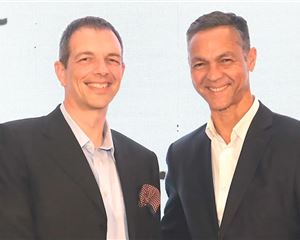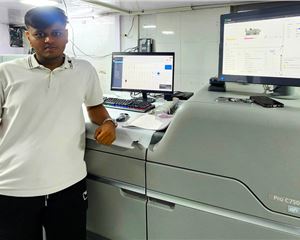NPES Print Business Conference 2013 Day two - session one
The morning session of the second day at NPES business conference mainly focused on the newspaper industry in India. With stalwarts of the newspaper publishing and printing industry in India like K Balaji, director, The Hindu , V Siva Raja, AVP, Hindustan Times and Shashank Chavan, Times of India up on the panel, it promised to be an interesting discussion.
26 Feb 2013 | By Mihir Joshi
The Indian newspaper industry is of the few growing newspaper industry in the world, while most of the so-called mature markets have seen a serious downturn.
K Balaji, director, The Hindu, started with a presentation on excellence in newspaper production with an eye on the future. He said, “The arrival of television once and for all ended the dominance of print as medium of information and entertainment and since then print has been in a tug-of-war with other media. The newest threat to emerge is the overwhelming number of smartphones that have flooded the marketplace, while digital has been chipping away at print’s revenue channels.”
“Print’s survival depends upon enhancing its business appeal and consolidating on its core strengths. Increasing literacy will ensure that newspaper will remain an attractive channel for advertisers. The knowledge of newspaper print has moved out of the publishing houses as publishers faced with declining print revenues sacrifice an under-utilised, high capital asset which is mainly printing. But the question is whether a publisher losses individuality due outsourced printing to a standardised organisation. Separation of printing and publishing might not guarantee success but can be part of carefully formulated business strategy,” Balaji added.
While concluding Balaji conceded that the fate of such a partnership will always depend upon the understanding of vision and limitations between the publisher and the printer.
Shashank Chavan from the Times of India took up the stage after Balaji and talked about 'Newspaper Publishing- Peek in to the future'. He said, “The advertising revenue for newspaper across the globe has declined by 44% between 2007 and 2009. Even in the Indian advertising market, share for print has come down from 51% 2007 to 46% in 2011. Though advertising revenue has increased percent share of the print advertising has declined drastically.”
He called for drastic innovation and content solidification if Indian market didn’t want to go down like its western counterparts, He added “The American print advertising has declined so much that, Google’s advertising revenue is more than the entire newspaper and magazine (print) revenue put together.”
V Siva Raja, AVP, Hindustan Times, talked about newspaper industry from the readers point of view, he said, “A reader doesn’t care for advertising numbers, a reader will choose what he/she thinks is best for them, thus content is very important. He called for more united organisation and synergy among newspaper publishers and to do away with price war which has led to subsidised newspaper which are sold at far lower prices than the production cost and thus over burdening the advertising revenue channels.”
The second panel of the pre-lunch session on day two of NPES print business conference consisted of suppliers who focused on the latest technological developments in press colour, waste reduction, newspaper trends and UV solutions.
Vince Balistrieri, general manager- commercial newspaper business, Quadtech started second session with a talk on press colours and waste reduction and the need for automation. He said, “With increasing production speeds, operational costs and costs of raw materials have added to pressures of a printer and to tackle these problems printers have turned towards automation. For the past 30 years demands have increased while staffing levels have decreased.”
He added, “Quality is of prime importance to attract advertisers and our colour management systems provide far better results compared to when the same process is done manually. Our algorithm based automated solution is so precise that the colour in every pixel can be micromanaged to give a more complete target image.”
“An automated colour control system minimise the operational intervention to 0.61 times for every 10,000 copies while the number can be as high 100 times per 10,000 copies when the process is not automated. Automated defect-detection systems also help increase quality and can help in plate verifications and detect problems like tramlines, scumming and ink contamination,” he concluded.
Timothy Ruth, VP, Manroland, was the second speaker for the session and he focused on trends in newspaper industry with special focus on newspaper markets in India and across the globe.
While talking about the Indian market, Ruth said, “India and some of the other developing countries are the few markets where printed newspapers have witnessed a growth, today the Indian newspaper industry is worth Rs 197-billion, with 329 million copies being printed every year.”
“Newspaper also enjoys a lion’s share of the advertising share that has been spent on print. Out of the total money spent on print advertising, 96% was in newspapers, though print advertising in general has seen a steady decline,” he added.
English newspaper growth numbers are being outpaced by regional newspaper and expansion into tier II and tier III centre are some of the latest trends in the Indian market. Indian newspaper publishers have resorted to various innovations in order to attract advertisers. 3D newspaper, scented inks and half covers are some of the innovation at work.
He also stressed on the need for creative marketing.
Albert Uhlemayr, president, Vegra took up the stage after Ruth and stressed on the need to act responsible and reducing our carbon footprint to make a better tomorrow. He said, “Everybody in a position to help reduce carbon emission should take necessary measures.”
Uhlemayr talked in depth about the problem of environmental contamination and carbon dioxide pollution is very high and requires careful planning by everyone involved and recycling should no longer be an option but a compulsion.
Rajeev Kapoor, chief executive officer, APL Machineries and Erich Midlik, executive VP, PrimeUV-IR who completed the panel talked about the benefits of an UV curing systems. While Kapoor talked about the ways a printer can go about acquiring UV and the things that should be kept in mind. Midlik talked about the advantages an UV system provides over its competition and some of the major installation carried out by Prime UV-IR.












 See All
See All